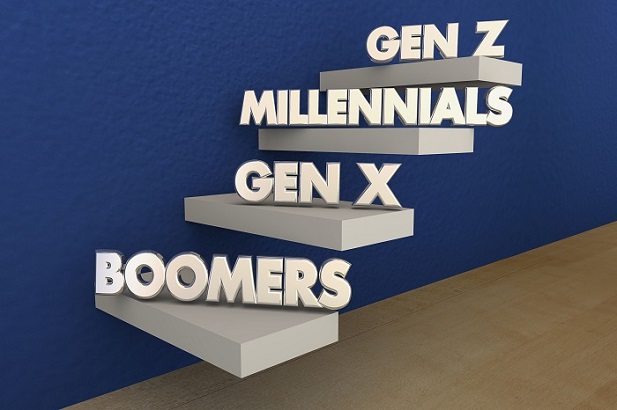 Employers would be wise to take proactive measures both to stay within the bounds of workplace discrimination laws and to capitalize on the benefits of a multigenerational workforce. (Photo: Shutterstock)
Employers would be wise to take proactive measures both to stay within the bounds of workplace discrimination laws and to capitalize on the benefits of a multigenerational workforce. (Photo: Shutterstock)
It is a challenging time for employers. A look around most workplaces finds every generational label society relies on as broad clichés: a boomer there, a Gen-Xer here, a millennial over there, and some Gen Zs too. It's a dramatic departure from times when the workplace was dominated by just two generations.
Related: Forget everything you know about millennial and Gen Z employee stereotypes
This seems to be a byproduct of a couple of things. One, people are living longer, healthier, happier lives as a result of better access to health care and adopting better health habits. Two, the Age Discrimination in Employment Act has had at least some of its desired impact with employers keeping and retaining its older employees in vital roles as opposed to seeking ways to shuffle them out the door.
Yet unlawful age discrimination in the workplace persists as a problem. In 2019, 15,573 charges of discrimination were filed with the Equal Employment Opportunity Commission alleging age discrimination. This was 21.4 percent of all charges filed last year with the federal agency. And the EEOC obtained $75.7 million in economic relief in those charges.
Avoid being part of those statistics by taking proactive measures both to stay within the bounds of the law and to capitalize on the benefits of a multigenerational workforce. Here are just a few tips to get started.
Set expectations
Every workplace practice has at its foundation a good, well-written policy. That policy has to be communicated to workers through handbooks, new hire orientation and periodic training. These are just the basics. Setting the standard for team building, overall respect in the workplace and avoiding age bias is very crucial to avoid exposure to liability and having your workplace breakdown along generational divides. While most workers understand that race- and gender-based harassment and discrimination are not tolerated in the workplace, negative age-based stereotypes are not as taboo. However, they are just as unlawful and counterproductive to business success.
Walk the talk
People learn from behaviors they see modeled more than they do from what they read or what they are told. And while paper-based policies are great, they are just the starting point. Business leaders have to set the example by showing up to trainings, voicing support of policies and, of course, managing in ways that demonstrate commitment to eradicating ageism in the workplace. And, they have to be held accountable when they fail to be the example.
It is also important to ensure that this respect goes both ways, and older, experienced workers should remember that they too were young and new once. "Before you criticize the younger generation, remember you were once that age and now, as an older adult, are extremely grateful that all of the stupid things we said or did were not captured on the internet forever for everyone to see in perpetuity, " says Jan Stewart, Vice President of Human Resources for NHS Management, LLC.
Trade stereotypes for employee engagement
It is easy for supervisors and managers to manage based on their presumptions about employees. One may assume that an older worker lacks the skills or interest to be effective at a technology-based task. Similarly, one may assume that a younger employee may lack the "people skills" to be an effective face-to-face communicator because of reliance on electronic devices. These are lazy and ineffective ways of managing people, and they are no more laudable or lawful than when managing employees based on stereotypes based on race or gender.
Management must be challenged to do the time-consuming and sometimes hard work of actually getting to know their employees. Motivating and engaging an employee to do their best work on matters that best suit them cannot be done without knowing that person's strengths and weaknesses, which are almost always different than those dictated through reliance on presumptions based on assumptions.
Release the stranglehold on career development
Make training and development opportunities available to all employees whose job may benefit from the training. Too often companies restrict such opportunities based on age, experience or how long they perceive that employee will continue to work or be with the company. At best, employees who feel their career development is being stymied will leave. Others may feel unappreciated and stuck, and could even result in their resignation – thereby severely diminishing their contributions to the success of the organization.
Manage to strengths, not weaknesses
Know what employees are best–and worst–at doing. This is not to say that employees should not be challenged to expand their proficiency at tasks or only be allowed to do what they want to do. Still, constantly setting an employee up for failure by assigning tasks and roles that are not well suited for an employee's personal strengths is counterproductive for both the employee and the company.
Many experienced employees will have valuable, personal contacts and relationships in the industry. They will also likely have vast institutional knowledge. Younger employees may be more versed in the latest methods and have valuable ideas about how to improve efficiencies and productivity. Both need to be respected and leveraged to the overall benefit of the organization.
Cross-train and share knowledge
Once individual employee strengths and knowledge can be identified, it will become apparent that everyone should have at least some familiarity and experience in those areas. Team building, knowledge sharing and cross-training among employees are valuable activities for companies, although many are loath to do it because it seems on the surface like a costly, time-wasting exercise. It does not directly result in the immediate production of more widgets or whatever the organization exists to do. However, it has many long-term benefits for both the company and employees.
Having experienced employees' share their industry connections and knowledge with newer employees can help accelerate the careers of the younger employees. Similarly, having younger employees actively engaged in sharing newer or more efficient methods can help more experienced workers obtain more job skills and stay relevant in the job market. From a business standpoint, it is good to have a more even level of performance and abilities among employees. Otherwise an organization can be crippled when one or a few employees who have hoarded valuable relationships or knowledge depart.
In contrast, constantly working in silos can create rivalries and division over the course of time. This can ultimately harm the organization and lead to behaviors demonstrating a lack of respect between employees, which is almost always the real root cause of discrimination and harassment claims against employers. It is much harder to behave boorishly to someone you know and respect.
Recognizing the value of a multigenerational workforce is the first step to solving the workplace puzzle. It is not a challenge; it is an opportunity to develop an agile workforce and a competitive edge. Every employee, regardless of age, can have something to contribute. But this culture is not going to establish itself. It has to be done intentionally and over time with focused effort.
Thomas W. Scroggins ([email protected]) is a partner in the Birmingham, Ala. office of Constangy, Brooks, Smith & Prophetee. He represents employers to defend against employee lawsuits, advise during union avoidance campaigns, negotiate collective bargaining agreements and design policies for local, regional, national and international employers of all sizes.
Read more:
© 2025 ALM Global, LLC, All Rights Reserved. Request academic re-use from www.copyright.com. All other uses, submit a request to [email protected]. For more information visit Asset & Logo Licensing.







